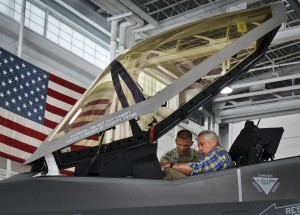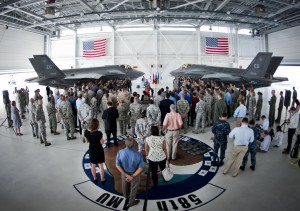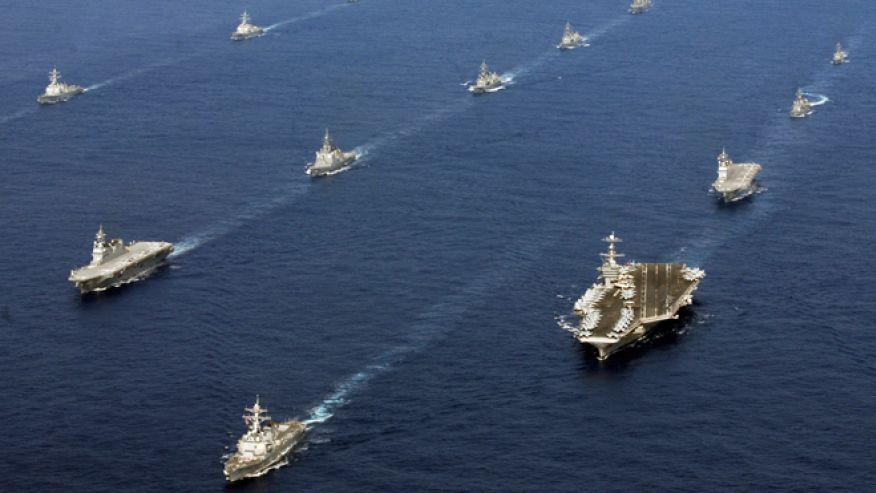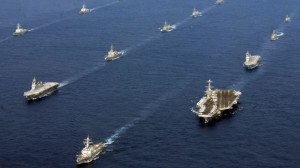2014-07-19 Recently, Secretary Hagel visited the 33rd Fighter Wing to reinforce his commitment to the way ahead and highlight the progress with the F-35 program.
Because you might have missed the extensive mainstream press’s coverage of the event, we thought you would like to hear what the Secretary himself chose to say.
And we can take this opportunity to highlight the fact that Second Line of Defense has just returned from a visit to Yuma Air Station where VFMA-121, the first operational F-35 squadron, and MAWTS-1 are preparing for IOC of the F-35 B next year. And we will soon be reporting on that visit.
Remarks by Secretary Hagel at a Troop Event, Eglin Air Force Base, Florida
July 10, 2014
Thank you. General, thank you. Thank you, and thank you for giving me a few minutes this morning. I appreciate, first, an opportunity to say hello, bring you greetings from President Obama and the people of the Defense Department, but also to tell you how much we appreciate what you do and the hard work, the effort, the sacrifice, the service that you give our country.
And I know it’s important to you, because you wouldn’t be doing this job if you didn’t feel pretty strongly about our country. I want you to know we know that. I want to thank your families and I want you, in particular, to tell your families and your spouses how much we appreciate their sacrifice and what they do to support you and do the things that families do to support each other. So, thank you.
I’ve had a tremendous morning here. I’ve had an opportunity to climb in the pit of this F-35. You can see it’s my plane. My name’s on it. They didn’t let me push any buttons this morning. But they gave me a very good sense of this aircraft, capabilities, what it can do, how important it’s going to be to our security.
I had an opportunity after that to meet with a number of Navy, Marine F-35 pilots and maintenance chiefs, as well, to take it a little deeper and go down a little (inaudible); not just the capabilities (inaudible) in particular, I wanted to get a sense of the pilots and the (inaudible) on what they think about the aircraft.
First question. Do you have confidence? Do you have confidence in this aircraft? Can it do what we believe it can do and will do?
And we went around the table, and I first told them I needed very clear and direct and honest answers. And they were very clear, direct and honest with me on what they thought about a lot of things, in particular this aircraft.

And I appreciated very much the evaluations, because the evaluations first were very clear that they had tremendous confidence in the aircraft.
Some of the pilots told me it was the best aircraft that they’d ever flown, and some said it was the easiest and simplest aircraft they’d ever flown.
I was particularly happy to hear that, because I believe this aircraft is the future for our fighter aircraft for our services.
This is as big a project, the F-35, as we have in the Department of Defense (inaudible) on this aircraft (inaudible) as well as (inaudible) around the world who have invested in this aircraft.
So that’s the first thing I want to tell you, is that I have strong, strong confidence in the people who make this aircraft fly, maintain it.
I know there are issues. I don’t know of a platform that we’ve ever had, we’ve ever designed (inaudible) and then put into service that didn’t go through issues.
And I know we will, as always (inaudible) that safety is the first priority. And we’re not going to put aircraft in the air, we’re not going to ask anyone to risk their lives on any platform for any reason unless we feel absolutely secure (inaudible) safe. That’s what we are evaluating now.
As you know, as the inspections have just been completed, and now they’re further investigating all the different dimensions of the results of those inspections.
Third, I want to also say that in regard to people, which is always the highest priority of our enterprise, you take care of your people, because (inaudible) always (inaudible) in every institution, and an institution is about people. This base represents that quality of people and the prioritization of our people, as well as any base we have in the world (inaudible) that I’ve focused on with, and along with people.
You need capabilities to do your job, to have the cutting-edge technology and capabilities and platforms to do the kind of job that America expects you to do, that you want to do, and this is a good example of that kind of capability.
Third, partnerships, which I talk a lot about. This base represents partnerships as clearly as any base that we have. Eight other countries are partners with the United States in investing in this platform. People, capabilities, platform, it all comes together as well as I’ve ever seen it come together at this — at this base.
And I wanted to acknowledge that, because I know sometimes we wonder — and I know you do — whether there’s any coordination to what you’re doing and why you’re doing it and what’s the mission and what’s the purpose. There is.
And I particularly wanted to note those three particular things, because those are the three essential elements and foundational pieces of the Department of Defense. And those are where our priorities are, and those will be the priorities that we will sustain over a long period of time.
You, as the individuals who make it happen, need to be assured of that. I also want to just mention a couple of other things that I knew you have questions on your minds about – budgets, about your futures, about missions – and I want to address a couple of those, and then we’ll open it up and talk about whatever you want to talk about and take questions.
First, budgets. You know that we are undergoing as intense a budget reduction process as this department has gone through in many, many years. I’m sure for all of you, or certainly most of you, this is the biggest, most abrupt, steepest budget reduction process in your careers. Unfortunately, that’s the world that we are dealing with. Sequestration has impacted our readiness. You’ve seen that. I talked to the pilots about it today, and when we last year had to stand down a lot of our flying — our training, this wasn’t just for flying, but our sailors, our ground troops couldn’t train. Readiness, maintenance were all affected. And we have tried to restructure our enterprise so that we will deal with these kinds of realities.
But I think what’s ahead is a continuation of these kinds of reductions, so we’re going to have to be smart in how we prioritize our resources, be clear in our missions, and be effective in how we operate. And I know you’re doing that, and I’m aware of that. We are making some progress in some areas.
But I wanted to bring up the budget issue, because I know it’s on your mind.
Second, how it affects you in your careers, your futures, your family. As I said, people are our first priority. People will continue to be our first priority. You take care of your people. That has to be balanced with readiness and capability, because one of the failures of leadership that we are always trying to avoid is having our people well-compensated, as you need to be, but at a cost where maybe you’re not as ready or capable as you need to be. And no leader of this institution, whether uniformed or non-uniformed, would ever send men and women into combat when you’re not ready. I won’t do it. I don’t think any secretary of defense would do it, any chief would do it, any leader would do it.
So we are balancing those issues. And I wanted to assure you that it’s as high a priority as I have, as the leaders of the Defense Department have. Uncertainty is a difficult thing to live with, especially with families, and especially for the younger men and women here who are at the front end of your careers or maybe in the middle of your careers. That uncertainty is difficult. But I want you to know, I’m paying attention to this. We’re all paying attention to this. We work with the Congress on this.
And we’re going to need some help from the Congress, and we’re talking to the Congress about we can’t continue this irresponsible deferral of sequestration, because it will impact — it will impact this enterprise. And so be assured, we’re working on it.

I also want to mention one other thing, and then we’ll open it up to questions. I know the world is today, as you know, because many of you have served all over the world, is as complicated and dangerous as maybe it’s ever been. And it is putting new requirements and pressures on all of you, on all of us, to deal with these — these threats and these dangers in a wise way, in a steady way, that assures our security.
These are difficult days. You all know that.
But these are days also that give us some opportunities to adjust and reset and recalibrate and do some things that will make us stronger in how we think and how we will respond, giving us a broader latitude of leadership and management that you never get when things are status quo.
And as we come down out of this second long war, the longest war America has ever been in, 13 years of constant large land wars, there’s always a natural reset and process to that. There are some opportunities in that.
But I think it’s important that we all understand that steady, wise, careful leadership is required today by the United States as maybe any time in your careers. Working with our partners and helping our partners build their capability, building strong relationships and partnerships, as I noted earlier, this new platform represents that. But there are other ways we’re doing that.
Our Navy’s doing it. Our Army’s doing it. Our Marine Corps, Air Force, Coast Guard in South America, we are doing things that we’ve never done before in building partnerships and helping our partners develop their capabilities to deal with these threats. We’ll always be the senior partner, but we need partners.
We always need friends around the world, and we need people around the world who are willing to work with us and we’re willing to work with them.
So I say that because, again, this base represents so much of that and the experience here in this — in this hanger and at this base and in your services represents so much of that, of what’s been accumulated over a number of years, of two long wars and other assignments around the world. So I thank you for that.
Again, I thank you for what you do. You do make a difference.
You are making a difference. You’re defining history. You are defining a new dynamic of world affairs, of security, and this platform is going to help do that as much as any platform we’ve had in recent times, the F-35.
But this would never work without you and without what you do. And, again, I want to acknowledge that and thank you.
http://www.defense.gov/Transcripts/Transcript.aspx?TranscriptID=5463
7/10/14
And the story written by Samuel King from Eglin Air Force Base about the event follows:
EGLIN AIR FORCE BASE, Fla. – “You make a difference. You are defining history,” said Defense Secretary Chuck Hagel, flanked by two F-35A Lightning IIs, during a troop call here July 10.
Hagel‘s four-hour tour of the 33rd Fighter Wing’s F-35 integrated training center included the mission simulator, a hands-on tour of an F-35A static display as well as a discussion with joint strike fighter pilots and maintenance chiefs.
After the meeting, Hagel said the pilots and maintainers were clear about what they thought about this aircraft.
“They told me this is the best aircraft they’ve ever flown and some said it was easiest they’ve ever flown. They gave me a very good sense of this aircraft, capabilities, what it can do, how important it is going to be for our national security. I was particularly happy to hear that because I believe this aircraft is the future fighter of our services.”
During the troop call, Hagel focused on safety first with reassuring words after a recent F-35 accident here temporarily suspended F-35A flying operations.
“We are not going to put aircraft in the air or ask anyone to risk their life on any platform for any reason unless we feel absolutely secure that it is safe,” he said. “That is what we are evaluating now as you know…..”
Members of the 33rd FW realize the significance of the defense secretary’s visit.
“It’s always an honor to have decision makers visit from D.C.,” said Lt. Col. Eric Smith, 33rd Operations Support Squadron commander.
“It signifies how important the program is to national defense.”



